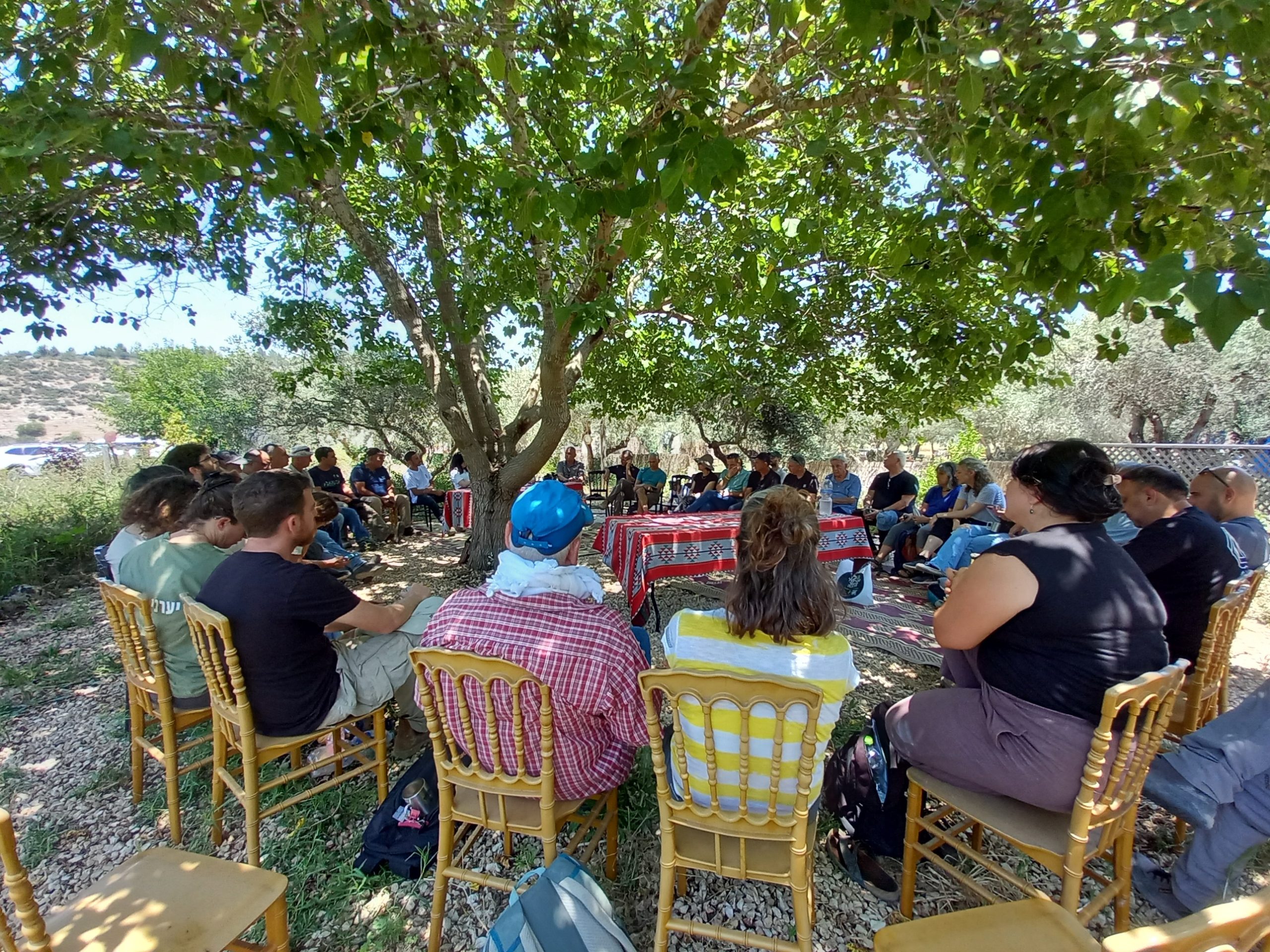Vision: "The Zippori Stream Basin will uphold a right ecosystem, preserve nature and heritage, connect communities, support leisure, research and innovation and will constitute a model of ecological basin preservation and management".
Zippori Stream – Nice to Meet!
Zippori Stream tells a story of human–nature connection spanning thousands of years. It begins in springs on the Nazareth ridge and flows west for 32 km before joining the Kishon River in Haifa Bay. Its basin covers about 300 km². Its flow continues most of the year thanks to its perennial springs, which were a vital water source for the human settlements in the area.
A remarkable chapter of this history is the ancient aqueduct system, built over 2,000 years ago, which carried water from Reineh and Mash’had to the city of Zippori, a small part of which has survived. Today, the stream winds through farmland, forests, nature reserves, pastures, and both rural and urban communities, reflecting a landscape rich in life and legacy.
Why Do Streams Need Restoration?
Humans have always settled near water sources. But human activity, accelerated development, and water over-extraction have caused pollution and harmed stream ecosystems. Many streams became regulated channels without natural vegetation, some polluted or dried up entirely. Stream restoration aims to return the ecosystem to a natural, balanced state, enabling it to regenerate independently.
Today, streams are seen as part of a broader water basin system, and restoration is planned with the needs of residents, nature, and stakeholders in mind, with a long-term vision. Understanding the stream’s condition and unique challenges is essential before beginning the restoration process.
Who’s Responsible?
Behind every stream stands a Drainage and Rivers Authority – the public body responsible for coordinating all actions related to drainage, flood risk management, and stream restoration across Israel. The Kishon Drainage and Rivers Authority is one of 11 such authorities, overseeing the 1,100 km² Kishon basin, which includes 35 local municipalities. Zippori Stream is a sub-basin of the Kishon.
Read more about the Kishon basin’s other streams [in Hebrew].
Why Restore Zippori Stream?
Like many streams in Israel, Zippori Stream and its tributaries have suffered from pollution, waste buildup, overgrazing, soil erosion, and disrupted water flow.
Over the years, the Kishon Authority has restored various segments to prevent further damage, improve water quality and stream structure, revive biodiversity, build hiking infrastructure, and strengthen public connection and responsibility toward the stream, all while preserving its unique character, surroundings, and heritage.
This restoration project emphasizes a basin-wide, interdisciplinary approach. In addition to the abovementioned goals, it aims to build partnerships, foster a shared space for all communities, support sustainable local agriculture, and promote eco-friendly tourism and recreation.
Zippori’s Ripple Effect
The Zippori Stream restoration plan, submitted by the Kishon Authority, won first place in the “Stream Corridor Restoration” competition by Yad Hanadiv–Rothschild Foundation, thanks to its innovative approach and groundbreaking planning.
It is currently the largest stream restoration project in Israel and serves as a model for integrated watershed rehabilitation. This holistic vision includes not just the stream but also its people, agriculture, partnerships, tourism, education, and more.
Launched in 2022, the project aims to inspire similar initiatives nationwide, advancing a long-term, integrative approach to stream restoration and management.
For the full vision (in Hebrew), click here.
How Is It Actually Done?
The Kishon Authority is leading the project together with Yad Hanadiv and many partners, including government ministries, local municipalities, nature conservation bodies, and more. The project team includes professionals from various fields who jointly design a holistic restoration plan.
The project includes physical interventions along the stream and within the basin, with reference to different restoration components, such as water quality improvement, habitat rehabilitation, community empowerment, flow restoration, encouraging eco-agriculture, trail development, accessibility, environmental education, and green economy initiatives. Most of the physical work is done in the dry months, with monitoring, maintenance, and planning performed year-round.
The Future of Zippori Stream
Restoring a stream isn’t a one-day task; It’s a gradual, long-term process. Even after major works are complete, ongoing maintenance, management, and community engagement are vital to preserve the restoration’s achievements.
Nature’s recovery takes years, including the slow return of local flora and fauna along the stream.
Therefore, even after the project ends, the Kishon Authority and its partners will continue working to keep Zippori Stream clean, thriving, and a central anchor for surrounding communities.

Restoration Components
Restoration Components
Successful restoration relies on addressing diverse aspects and integrating them effectively.
Learn More


Partners Along the Way
Partners Along the Way
Zippori Stream’s restoration wouldn’t be possible without the many organizations involved.
Learn More


Project Team
Project Team
The team is made up of top professionals working together with full commitment to the project’s success.
Learn More

On-Site Projects
On-Site Projects
Across the stream, actions include flow regulation, trail construction, plant restoration, and more
Learn More
Restoration Components
Successful stream restoration isn’t simple, it requires a broad vision, attention to diverse topics, and deep collaboration across disciplines: water, ecology, landscape, agriculture, education, partnerships, community, recreation, and local economy. This holistic basin-wide approach ensures long-term sustainability for generations to come.
Click on the Restoration Flower on the left to explore each component.
Water
Zippori Stream and its tributaries have served as a central water source for human settlement and agricultural activity in the basin for thousands of years. However, modern life along the stream has led to water quality degradation due to multiple factors: effluent discharge from wastewater treatment facilities, sewage overflows due to system failures, and runoff from agricultural fields…
Goals
- Improve water quality – address the main sources of pollution across the basin and monitor water quality through continuous tracking.
- Restore natural, continuous flow to the stream and its tributaries…
Ecology
The streambed and banks of Zippori Stream create a unique habitat for a wide variety of plant and animal species. The stream’s year-round flow enables many species to thrive, but modern human influences have harmed its ecological system. Overgrazing, water pollution, and invasive species competing with local ones have disrupted the natural balance. A central part of the restoration is…
What are we doing in practice?
- We conducted extensive surveys and monitoring before starting the work, to ensure planning was based on accurate data, and to allow us to measure the impact on the stream’s environment.
- We are restoring the streambed by widening it, adding meanders, and softening the bank slopes to return it to its natural structure.
- As part of a “citizen science” initiative…
Agriculture
For nearly its entire length, Zippori Stream runs near or through agricultural lands owned by communities or private farmers. Therefore, the restoration project must address the complex relationship between agriculture and the stream, which is a complex relationship of mutual impact. On one hand, the stream may damage farmland through flooding in winter or help spread invasive plants and pests. On the other hand, modern agriculture can harm the stream via pesticide and fertilizer runoff, soil erosion, or farming too close to the stream, which can damage the banks. Cattle and sheep herds can also…
To Agriculture PageLand Management
Land management includes addressing various needs: regular maintenance and mowing of stream vegetation, including removal of invasive species and flood prevention preparation for winter; waste management, one of the biggest and most difficult challenges, through routine cleanup of the stream area and removal of debris washed in during rain events; and visitor management, including separating different user types where possible and distributing visitor load along the stream. In every area…
Goals
1. Maintenance system – develop and establish long-term capabilities for operations, enforcement, monitoring, and maintenance across the stream environment, in cooperation with various bodies – Israel Nature and Parks Authority, KKL-JNF, the Green Police, regional councils, and more.
2. Visitor management and usage separation…
Sustainable Local Economy
Sustainable local economy and tourism are essential parts of long-term stream restoration. Economic activity can either harm or support restoration processes. The project emphasizes working with entrepreneurs and residents to develop environmentally friendly economic infrastructure. This includes supporting farmers who practice ecological farming that benefits both the environment and local communities. In addition…
What are we doing in practice?
- Training programs for residents to promote social–environmental–economic initiatives, such as nature guides, fitness instructors in nature areas, and facilitators of traditional crafts.
- Professional training for tourism professionals and entrepreneurs to encourage local tourism products. These included cheesemaking workshops, sourdough bread baking, spoken Arabic courses…
Landscape Design
The unique landscape of Zippori Stream, with its forests and open spaces, has long drawn visitors, both locals and tourists. Landscape development aims to shape a clear identity for the stream area and connect it to the surrounding communities through design elements.
As part of the project, for the first time in Israel, a unified design language was developed for the entire basin. This visual identity is reflected in trails, seating areas, bridges, and other features. It tells a “basin story” and is embodied in a continuous walking trail stretching along most of the stream, from which side-trails branch out…
Some of these connect the stream to nearby towns, making it easier for locals to access the stream.
To Landscape Design PageEducation
The goal of the education component is to foster a deep connection between youth and the stream environment. Activities are conducted with students from within and beyond the basin, across formal and informal educational settings. We use innovative, hands-on field-based programs that encourage exploration, research, and engagement.
The core principle is hands-on learning, involving practical restoration work that builds long-term environmental commitment.
Together with guides and teachers, students explore the restoration process, ecological systems, and the human-nature connection, while developing respect and care for the environment.
Education continues beyond school: students become “ambassadors” of environmental awareness in their homes and communities.
To Education, Society & Community PageCommunity & Society
A key to sustainable stream restoration is connecting basin communities to the restoration processes and basin’s space. The more residents feel a sense of belonging to the stream, there will be more expressions of environmental responsibility, care, and stewardship of the stream environment.
Social engagement as part of the stream’s restoration includes leadership development, community-building within towns and among thematic groups through shared activities, turning the stream into a meaningful place for residents, mapping and integrating local stories, and training community members to lead local initiatives. The social engagement also emphasizes Zippori Stream as a shared space, creating opportunities for connection between members of different communities.
Main Objectives:
- Develop connected, engaged leadership for the restoration of the stream’s environment: train leaders, empower activists, and build a basin-wide leadership network
- Placemaking: turn the stream into a place of meaning and identity for locals
- Build sustainable partnerships to support long-term social processes
- Create shared spaces by connecting diverse communities and individuals
Restoration Components
Subscribe to Our Newsletter
Want to stay updated on the Zippori Stream restoration project? Our bi-monthly newsletter (in Hebrew) includes all the latest updates and information!

